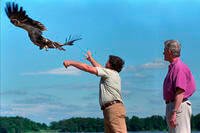Dwight David, one of seven sons of David and Ida Eisenhower, was born October 14th, 1890, in Denison, Texas. He entered the US Military Academy in 1911, where he graduated in the upper third of his class in 1915. After two years with the 19th Infantry at Fort Sam Houston, Texas, Eisenhower's career accelerated with the Army’s expansion for WWI.
By 1917, he had risen to the temporary grade of lieutenant colonel. Although he never went to France, Eisenhower commanded Camp Colt, the Army's tank corps training center at Gettysburg.
When the United States into WWII, Eisenhower took over the Army War Plans Division to draft a basic strategy for the war against the Axis. As a result of his efforts, Eisenhower was promoted to Commanding General, European Theater on June 25, 1942.
Soon after his arrival, he led British and American troops in North Africa during Operation TORCH. By the end of 1943, Eisenhower had conducted successful landings in Sicily and Italy and negotiated an Italian surrender.
Due to his successes, the Combined Chiefs of Staff named him Supreme Commander of the Allied Expeditionary Force for the invasion of Europe. Codenamed Operation OVERLORD, the attack across was to be the decisive act of the World War II. The Germans were aware of the Allied force build-up in the United Kingdom and anticipated an attack somewhere on the French coast. It was Eisenhower’s job to surprise the Germans in the time and place of the landings. Complicating matters was the fact that the Allied resources were sufficient for only one invasion attempt. After painstaking planning, Eisenhower launched the invasion on June 6, 1944.
Following the beginning of the invasion, Eisenhower could to little but wait. In no way assured of success, he actually drafted letters both for the success and failure of the landing. However, the brave men on Gold, Sword, Juno, Omaha and Utah beaches managed to gain a solid beachhead by late afternoon. By the end of June, the Allies had moved nearly one million men and over 585,000 tons of supplies over the beaches. Following of the success of OVERLORD, Eisenhower launched a second landing in the south of France to trap the Germans in converging pincers and force them to retreat from France. Eisenhower remained in command of the Allied forces through the unconditional surrender given to him by General Alfred Jodl at the SHAEF headquarters in Rheims.
Following WWII, Eisenhower was appointed the Army’s Chief of Staff in 1945. In 1952 he was elected President of the United States. As president, he achieved a great deal including signing the treaty to end the Korean War, lobbying Congress to pass the Federal Aid Highway Act in 1956 and enforcing school desegregation in Little Rock, Ark. Additionally, he signed legislation to create the National Aeronautics and Space Administration (NASA) and oversaw the statehood of Alaska and Hawaii.















